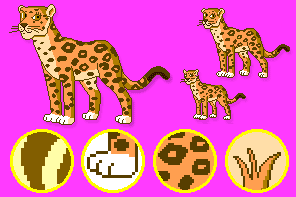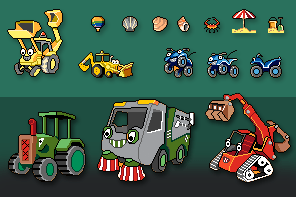Created by Sheismartha Studios //
What is Pixel Art ?
People usually ask the same question when they see Pixel Art for the first time….”Are there any specific programs that create pixel icons?”…
The answer is that there’s neither a specific software tool nor effect can create pixel icons or change a photo into a pixel icon.
Try to imagine a painting. The painter uses his brushes and his colors in order to create his artwork. The same thing happens with Pixel Art. Your canvas is a designing program, your brushes are the pencil with 1 pixel diameter, imagination, patience and a personal way to see things!
Click to see all the Levels of the Game!
See all the Pixel Art & Comics Projects // created by Sheismartha Studios
Uses
Pixel art was very often used in older computer and console video games. With the increasing use of 3D graphics in games, pixel art lost some of its use. Despite that, this is still a very active professional/amateur area, since mobile phones and other portable devices still have low resolution and therefore require skillful use of space and memory. Sometimes pixel art is used for advertising too. One such company that uses pixel art to advertise is Bell. The group eboy specializes in isometric pixel graphics for advertising and has been featured in magazines such as Wired, Popular Science, and Fortune 500.
Icons for operating systems with limited graphics abilities are also pixel art. The limited number of colors and resolution presents a challenge when attempting to convey complicated concepts and ideas in an efficient way. On the Microsoft Windows desktop icons are raster images of various sizes, the smaller of which are not necessarily scaled from the larger ones and could be considered pixel art. On the GNOME and KDE desktops, icons are represented primarily by SVG images, but also with hand-optimized, pixel art PNGs for smaller sizes such as 16×16 and 24×24. Another use of pixel art on modern desktop computers is favicons.
Modern pixel art has been seen as a reaction to the 3D graphics industry by amateur game/graphic hobbyists. Many retro enthusiasts often choose to mimic the style of the past. Some view the pixel art revival as restoring the golden age of second and third generation consoles, where it is argued graphics were more aesthetically pleasing. Pixel art still remains popular and has been used in social networking virtual worlds such as Citypixel and Habbo, as well as among hand-held devices such as the Nintendo DS, Nintendo 3DS, PSP, PS Vita and Cellphones, and in modern indie games such as Hotline Miami and FTL: Faster Than Light.
Isometric / Non-isometric
Pixel art is commonly divided in two subcategories: isometric and non-isometric. The isometric kind is drawn in a near-isometric dimetric projection. This is commonly seen in games to provide a three-dimensional view without using any real three-dimensional processing. Technically, an isometric angle would be of 30 degrees from the horizontal, but this is avoided since the pixels created by a line drawing algorithm would not follow a neat pattern. To fix this, lines with a 1:2 pixel ratio are picked, leading to an angle of about 22.6 degrees (arctan 0.5).






